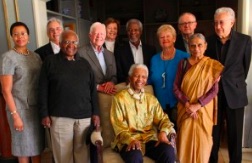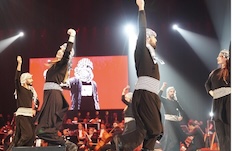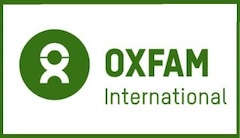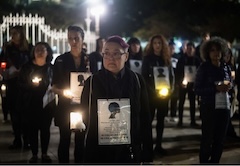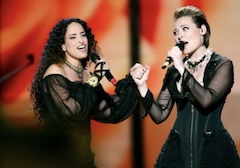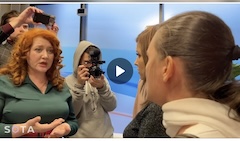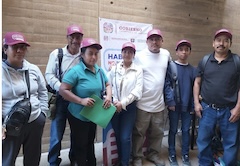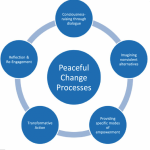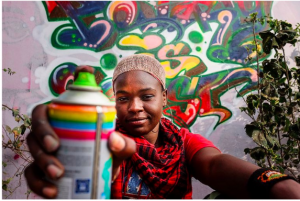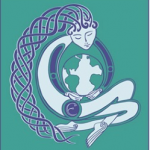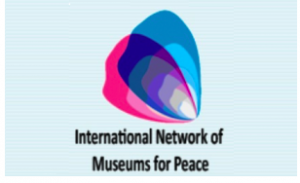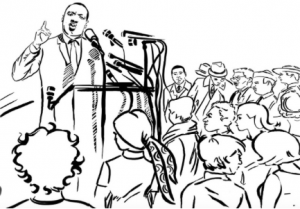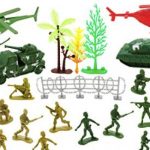. ARTISTS FOR PEACE . .
The struggle continues to stop the genocidal attacks by Israel against the people of Gaza. The International Court of Justice, responding to the complaint brought by South Africa, has issued orders to Israel to refrain from genocidal actions. Although there is no enforcement mechanism, the ruling reinforces the growing movement demanding a ceasefire.
People around the world continue to protest in solidarity with Palestine. On January 13 there were demonstrations involving up to a half million people, in Washington DC and London, as well as other demonstrations in Paris, Berlin, Rome, Johannesburg, Abuja, Tokyo, Islamabad, Jakarta, Kuala Lumpur, Milan, Dublin, Basel, Amsterdam, Oslo, Uppsala and Tunis.
Artists are playing an important role.
With regard to the genocide against Gaza, artists have mobilized in the UK, US, South Africa, France, Qatar, Dubai, Malaysia, Canada, India, and even in Israel itself. They have staged solidarity events such as murals, exhibitions of paintings, sand sculptures, and the reading of monologues by Gazan youth. Thousands of artists have signed declarations such as that of Musicians for Palestine, Artists for Palestine UK, #MusicForACeasefire, Artists4Ceasefire, and the peace memorandum of artists in Malaysia or they have led events such as the march for peace in Paris.
Singers Mira Awad and Noa, two Israelis, one Arab, the other Jewish, are singing for peace between Israel and Palestine. In December they were featured in a concert of the Berlin Philharmonic.
150 artists, singers, dancers and actors went on stage at the Algiers Opera Boualem Bessaih on January 20 in a gala of solidarity to raise money for Palestine. The event was sold out and broadcast on television.
A special CPNN article is dedicated to the young Palestinian artist Amal Abu al-Sabah who paints murals on the rubble of buildings that have been destroyed, “in order to send a strong message that we will remain on our land and never leave it.”
Responding to the attempts of the German government to ban demonstrations of support for Palestine, hundreds of artists and cultural workers around the world signed a petition calling to boycott German cultural institutions.
Artists are mobilizing for other peace and justice initiatives as well.
In the United States, support for the Black Lives Matter movement is being played out on the major stages of dance. Choreographer Jamar Roberts’s “Ode,” a somber and sensuous dance first performed in 2019 as a response to gun violence, was restaged for the Alvin Ailey American Dance Theater’s 65th anniversary in December. Last May, Chanel DaSilva’s “Tabernacle” premiered at the Dallas Black Dance Theatre, fusing Afrofuturism, hip hop, and African dance in a direct response to BLM. And last fall, the French-Malian choreographer Smaïl Kanouté’s “Never Twenty One” made its New York debut, its title borrowed from a BLM slogan.
In Colombia, 45 Singers, poets, dancers and musicians have answered the call of the Office of the High Commissioner for Peace and created an album of music to send a message against violence: “enough is enough”. The album contains a mix of Afro-Colombian rhythms, ordinary songs and rap.
In Turkey, hundreds of artists have called for negotiations on a peaceful solution to the Kurdish question. The declaration “Let us be a voice for peace”, is signed by 564 personalities, including prominent musicians, writers, directors, actresses, photographers and painters. It includes the following statement, “We, the people of art and literature, will not stand by and watch Turkey waste another century, propose to weave together a future in which all ethnic, religious and cultural identities live freely and are not oppressed or subjected to pogroms.”
In France, 121 personalities from the cultural and intellectual world have signed an appeal in support of the Turkish declaration, including among the signatories Annie Ernaux and Edgar Morin, and the “Voice for Peace in Kurdistan” collective organized a solidarity conference in Marseille on Saturday, 13 January.
In Cuba, cultural institutions including Cuban Institute of Cinematographic Art and Industry, the House of the Americas, the House of the Film Festival, the Foundation of New Latin American Cinema, the International Film School, the Ludwig Foundation of Cuba, the National Ballet of Cuba, the Hermanos Saiz Association and the Union of Writers and Artists of Cuba issued a declaration in support of artists from Argentina in the face of Javier Milei’s attacks on the cultural institutions of that country.
In Algeria, the National Graffiti Festival awarded first prize to the artist Fethi Mjahed for his murals that raise awareness of citizenship ad disseminate the culture of peace.
In Mexico City, the work of 12 artists is on exhibit to promote peace in their neighborhoods of the city. From the portraits made by Esteban Viveros of the people who live in the Guerrero neighborhood; to the landscapes of Jessica Islas, who denounces the burning of the forests in Xochimilco; and the collective work of Atardecer Dwsk that demonstrates that art heals the hearts of those who feel loneliness and depression, the creators seek to question prejudices about the places they inhabit.
With regard to the war in the Ukraine, CPNN readers may recall that many Russian artists, including writers and poets, musicians and music industry workers, television celebrities, hosts and showpeople, actors and actresses, filmmakers, comedians and stand-up artists, opera singers, fashion models, ballet dancers, orchestra conductors, and theater directors are among those who dared to oppose the war last year. Perhaps the most famous is Alla Pugacheva, Russia’s most beloved pop singer.
Speaking at the meeting of Turkish artists, Feyyaz Yaman from Karşı Sanat (Counter Art) expressed the urgent task confronted by artists today. “The silencing environment we are experiencing all over the world today prompts us to seek our rights. If art is to speak a critical language, then it must first weave rights and the coexistence of peoples. We invite artists to stand together against those who continuously impose a process of extermination and to claim this need. We have something to do for this, we need to produce a process of real dialogue. We have to bring together and defend the injustices we have suffered in this environment of differences on our common ground of righteousness. As those who believe in the power of art, we invite everyone to re-establish this peace.”
